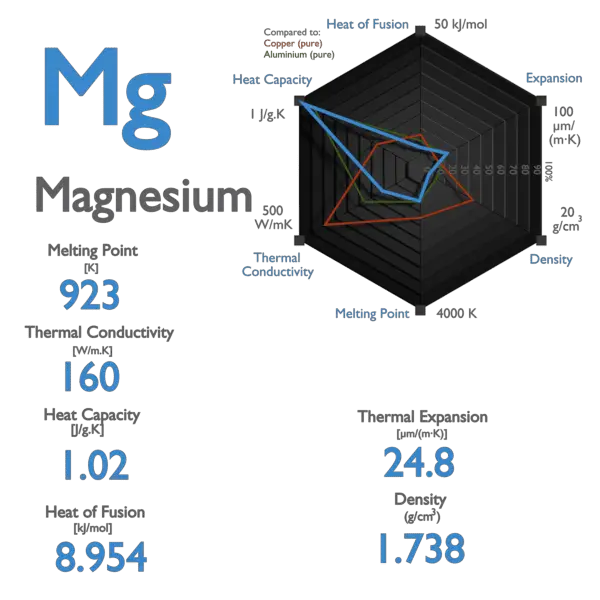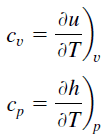Specific Heat Of Magnesium Sulfate
Magnesium – Specific Rut, Latent Heat of Fusion, Latent Heat of Vaporization
Specific heat of Magnesium is 1.02 J/g G.
Latent Rut of Fusion of Magnesium is 8.954 kJ/mol.
Latent Heat of Vaporization of Magnesium is 127.4 kJ/mol.

Specific Oestrus
Specific heat, or specific estrus capacity,is a property related to internal energy that is very important in thermodynamics. Theintensive backdropcv and cp are defined for pure, simple compressible substances equally fractional derivatives of theinternal energyu(T, 5) andenthalpyh(T, p) , respectively:

where the subscriptsv andp denote the variables held fixed during differentiation. The propertiescvandcp are referred to asspecific heats(orheat capacities) considering under certain special conditions, they relate the temperature change of a organization to the amount of energy added by heat transfer. Their SI units are J/kg.G orJ/mol K.
Dissimilar substances are afflicted todifferent magnitudes by theadd-on of heat. When a given amount of heat is added to different substances, their temperatures increase by different amounts.
Heat chapters is an all-encompassing property of affair, pregnant information technology is proportional to the size of the organisation.Heat capacity C has the unit of measurement of free energy per degree or energy per kelvin. When expressing the aforementioned miracle as an intensive property, theestrus capacity is divided past the amount of substance, mass, or book. Thus the quantity is independent of the size or extent of the sample.

Latent Rut of Vaporization

In general, when a material changes phase from solid to liquid or from liquid to gas, a certain amount of energy is involved in this change of phase. In the instance of liquid to gas phase change, this amount of energy is known as the enthalpy of vaporization (symbol ∆Hvap; unit: J), also known every bit the (latent) oestrus of vaporization or heat of evaporation. As an example, see the effigy, which describes the stage transitions of water.
Latent heat is the amount of heat added to or removed from a substance to produce a phase change. This free energy breaks down the attractive intermolecular forces and must provide the energy necessary to expand the gas (the pΔV work). When latent heat is added, no temperature change occurs. The enthalpy of vaporization is a function of the pressure at which that transformation takes place.
Latent Heat of Fusion
In the example of solid to liquid phase change, the change in enthalpy required to alter its land is known as the enthalpy of fusion (symbol ∆Hfus; unit: J), also known as the (latent) heat of fusion. Latent heat is the amount of estrus added to or removed from a substance to produce a stage change. This energy breaks down the bonny intermolecular forces and must provide the free energy necessary to expand the system (the pΔV work).
The liquid phase has higher internal energy than the solid phase. This means energy must exist supplied to a solid to melt information technology. Free energy is released from a liquid when it freezes considering the molecules in the liquid experience weaker intermolecular forces and have higher potential free energy (a kind of bail-dissociation energy for intermolecular forces).
The temperature at which the phase transition occurs is the melting point.
When latent heat is added, no temperature change occurs. The enthalpy of fusion is a role of the pressure at which that transformation takes place. By convention, the pressure level is assumed to be i atm (101.325 kPa) unless otherwise specified.

Magnesium – Backdrop
| Element | Magnesium |
|---|---|
| Atomic Number | 12 |
| Symbol | Mg |
| Element Category | Alkaline metal Earth Metal |
| Phase at STP | Solid |
| Atomic Mass [amu] | 24.305 |
| Density at STP [g/cm3] | 1.738 |
| Electron Configuration | [Ne] 3s2 |
| Possible Oxidation States | +2 |
| Electron Affinity [kJ/mol] | — |
| Electronegativity [Pauling scale] | ane.31 |
| 1st Ionization Energy [eV] | 7.6462 |
| Year of Discovery | 1755 |
| Discoverer | Black, Joseph |
| Thermal properties | |
| Melting Point [Celsius scale] | 649 |
| Boiling Signal [Celsius scale] | 1090 |
| Thermal Conductivity [W/yard K] | 156 |
| Specific Heat [J/g K] | 1.02 |
| Heat of Fusion [kJ/mol] | eight.954 |
| Rut of Vaporization [kJ/mol] | 127.4 |
Magnesium in Periodic Table
| Hydrogen 1 H | Helium 2 He | ||||||||||||||||||
| Lithium 3 Li | Beryllium four Exist | Boron 5 B | Carbon half dozen C | Nitrogen 7 North | Oxygen 8 O | Fluorine 9 F | Neon 10 Ne | ||||||||||||
| Sodium 11 Na | Magnesium 12 Mg | Aluminium 13 Al | Silicon 14 Si | Phosphorus 15 P | Sulfur xvi S | Chlorine 17 Cl | Argon 18 Ar | ||||||||||||
| Potassium xix K | Calcium 20 Ca | Scandium 21 Sc | Titanium 22 Ti | Vanadium 23 V | Chromium 24 Cr | Manganese 25 Mn | Atomic number 26 26 Atomic number 26 | Cobalt 27 Co | Nickel 28 Ni | Copper 29 Cu | Zinc 30 Zn | Gallium 31 Ga | Germanium 32 Ge | Arsenic 33 Equally | Selenium 34 Se | Bromine 35 Br | Krypton 36 Kr | ||
| Rubidium 37 Rb | Strontium 38 Sr | Yttrium 39 Y | Zirconium twoscore Zr | Niobium 41 Nb | Molybdenum 42 Mo | Technetium 43 Tc | Ruthenium 44 Ru | Rhodium 45 Rh | Palladium 46 Pd | Silver 47 Ag | Cadmium 48 Cd | Indium 49 In | Can fifty Sn | Antimony 51 Sb | Tellurium 52 Te | Iodine 53 I | Xenon 54 Xe | ||
| Caesium 55 Cs | Barium 56 Ba | Lanthanum 57 La | | Hafnium 72 Hf | Tantalum 73 Ta | Tungsten 74 W | Rhenium 75 Re | Osmium 76 Bone | Iridium 77 Ir | Platinum 78 Pt | Gold 79 Au | Mercury 80 Hg | Thallium 81 Tl | Lead 82 Pb | Bismuth 83 Bi | Polonium 84 Po | Astatine 85 At | Radon 86 Rn | |
| Francium 87 Fr | Radium 88 Ra | Actinium 89 Ac | | Rutherfordium 104 Rf | Dubnium 105 Db | Seaborgium 106 Sg | Bohrium 107 Bh | Hassium 108 Hs | Meitnerium 109 Mt | Darmstadtium 110 Ds | Roentgenium 111 Rg | Copernicium 112 Cn | Nihonium 113 Nh | Flerovium 114 Fl | Moscovium 115 Mc | Livermorium 116 Lv | Tennessine 117 Ts | Oganesson 118 Og | |
| | Cerium 58 Ce | Praseodymium 59 Pr | Neodymium 60 Nd | Promethium 61 Pm | Samarium 62 Sm | Europium 63 Eu | Gadolinium 64 Gd | Terbium 65 Tb | Dysprosium 66 Dy | Holmium 67 Ho | Erbium 68 Er | Thulium 69 Tm | Ytterbium lxx Yb | Lutetium 71 Lu | |||||
| | Thorium 90 Th | Protactinium 91 Pa | Uranium 92 U | Neptunium 93 Np | Plutonium 94 Pu | Americium 95 Am | Curium 96 Cm | Berkelium 97 Bk | Californium 98 Cf | Einsteinium 99 Es | Fermium 100 Fm | Mendelevium 101 Md | Nobelium 102 No | Lawrencium 103 Lr | |||||
–
–
–
Specific Heat Of Magnesium Sulfate,
Source: https://www.nuclear-power.com/Magnesium-specific-heat-latent-heat-vaporization-fusion/
Posted by: andersonates1978.blogspot.com


0 Response to "Specific Heat Of Magnesium Sulfate"
Post a Comment